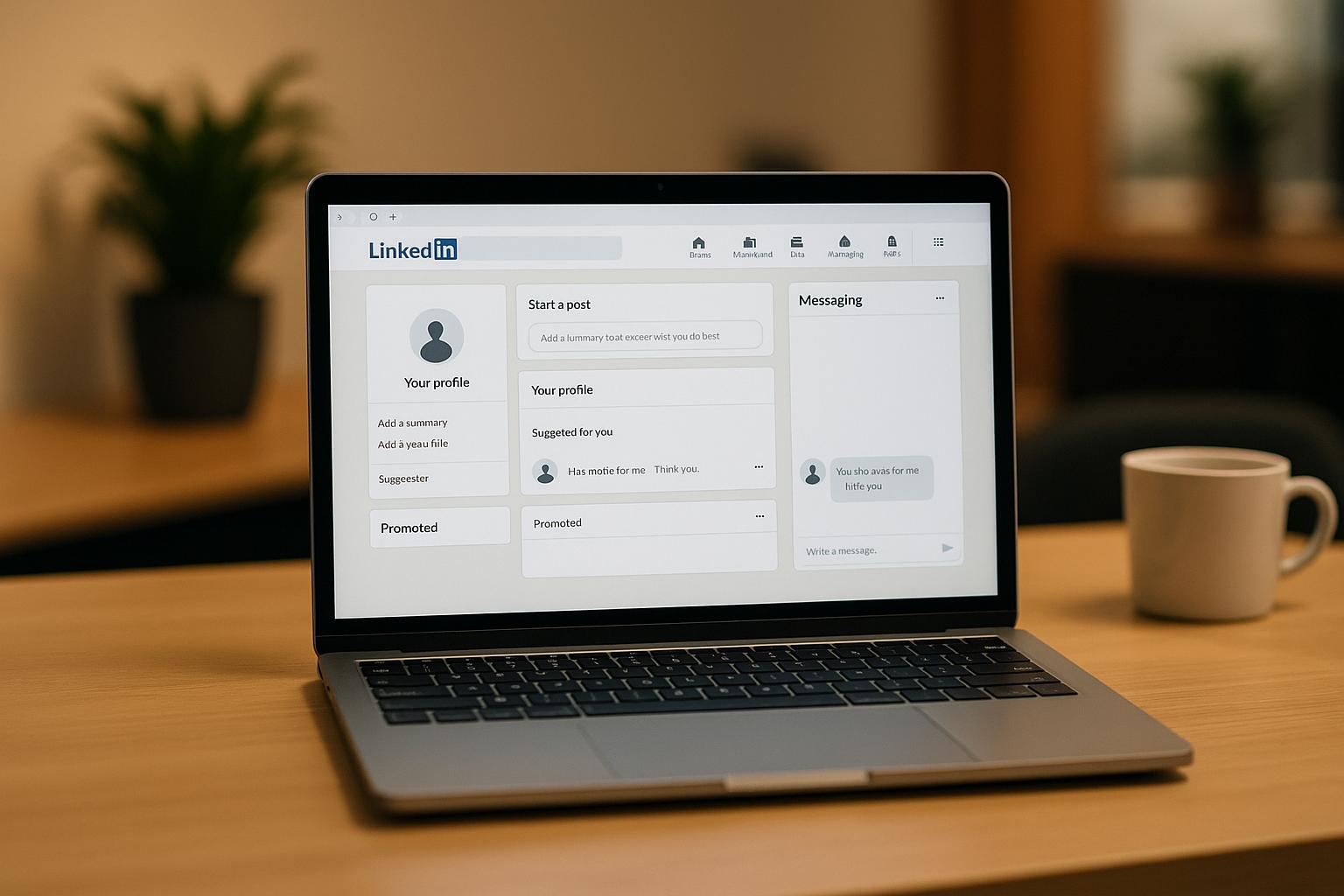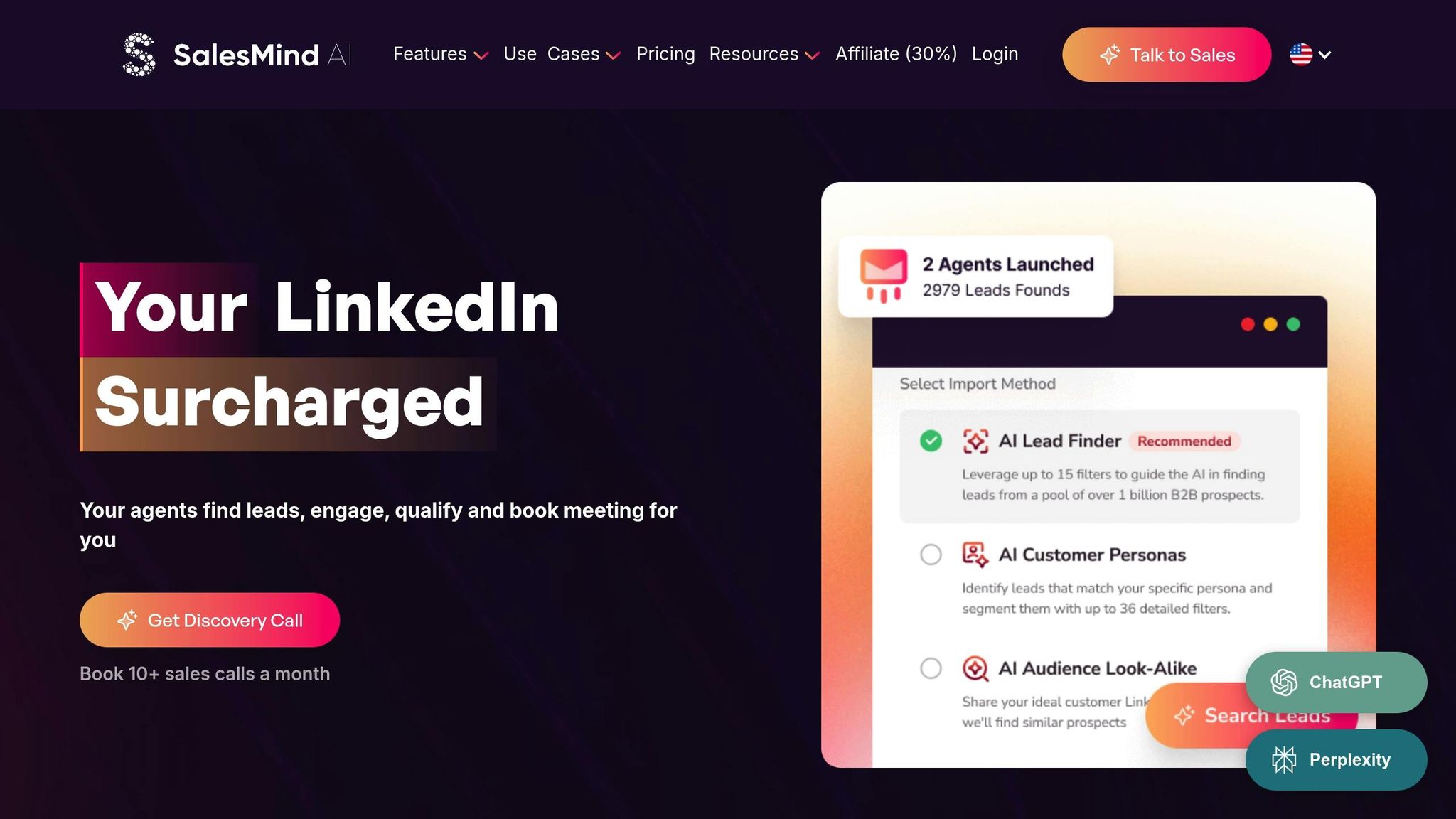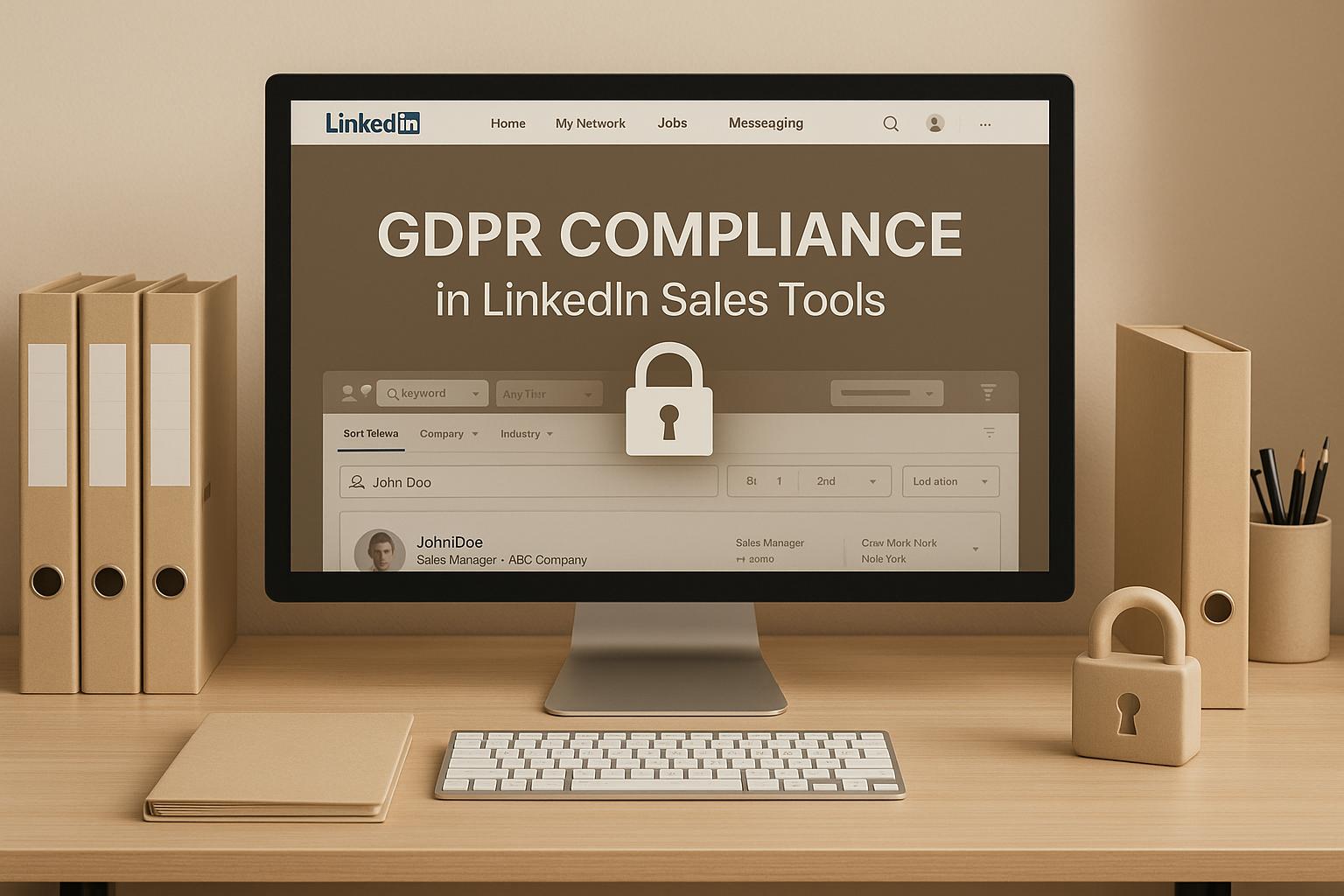
.avif)
Julien Gadea
Julien Gadea specializes in AI prospecting solutions for business growth. Empowering businesses to connect with their audience with SalesMind AI tools that automate your sales funnel, starting from lead generation.
Automating LinkedIn messages can save you time and improve efficiency, but doing it wrong risks your account being suspended or permanently banned. The key is to follow LinkedIn's rules, use compliant tools, and focus on personalization. Here's what you need to know:
- Why Automate: Automation helps scale outreach and personalize messages efficiently.
- Why Rules Matter: Violating LinkedIn's policies can lead to penalties like account suspension or bans.
- Safe Tools: Use tools like SalesMind AI that mimic human behavior, vary message timing, and personalize content.
- Best Practices: Limit activity to realistic levels, avoid repetitive messages, and focus on quality over quantity.
- Message Tips: Personalize messages, keep them under 100 words, and avoid aggressive sales language.
- Track Performance: Use analytics to monitor response rates, test different approaches, and refine your strategy.
How to Automate LinkedIn Outreach Without Getting Banned (Full Strategy)
LinkedIn's Automation Rules and Policies
Understanding LinkedIn's policies is key to creating a reliable outreach strategy. These rules are designed to maintain the platform's integrity, and knowing them can help you use automation tools without risking your account.
What LinkedIn Says About Automation
LinkedIn strictly prohibits the use of bots, scrapers, and unauthorized third-party tools. This includes automated activities like scraping profile data, collecting contact details, or sending connection requests and messages through unapproved software.
Automation violations generally occur when software is used to mimic actions that a person would typically perform manually. Examples include mass messaging, sending bulk connection requests, or automating profile visits.
The platform uses advanced detection systems to identify suspicious behavior. Accounts that show consistent activity patterns, rely on identical message templates, or operate at speeds beyond what a person could manage are flagged. LinkedIn also monitors API usage closely, allowing only authorized applications to integrate with the platform. Tools that automate tasks without official API access are considered a violation of LinkedIn's terms.
To avoid these risks, it’s essential to follow the platform’s rules carefully.
Rules You Must Follow
To stay compliant, maintain realistic activity levels, personalize every interaction, and vary your outreach timing to mimic natural behavior.
Focus on quality over quantity. LinkedIn rewards accounts that prioritize meaningful engagement rather than high-volume outreach.
Ensure your profile is complete and up to date. A detailed profile with recommendations and a well-developed network is less likely to attract scrutiny.
Pay attention to how recipients respond to your messages. Persistent low engagement can lead to LinkedIn limiting your messaging capabilities.
By adhering to these guidelines, you can reduce the chances of facing penalties.
What Happens When You Break the Rules
Breaking LinkedIn's automation policies can lead to penalties and damage the trust of your network. The consequences depend on the severity and frequency of the violations.
Penalties can range from temporary restrictions to permanent bans. For minor infractions, LinkedIn may temporarily limit your ability to send messages, connection requests, or perform searches. More serious violations could result in account suspension, during which many features are disabled while LinkedIn investigates.
In extreme cases, LinkedIn may permanently ban your account. This means losing access to your profile, network, message history, and other data, with little chance of recovery. Another possible consequence is shadow banning, where your account appears functional, but your content and messages are significantly limited in reach.
The impact of these penalties can be severe, restricting your access to LinkedIn's features, damaging your professional reputation, and costing you valuable networking and business opportunities.
How to Choose Safe AI-Powered Outreach Tools
When selecting automation tools for LinkedIn outreach, it's crucial to prioritize platforms that not only simplify your sales process but also safeguard your account. A good tool should deliver personalized messaging while adhering to practices that keep your profile secure. Let’s dive into how SalesMind AI achieves this balance.
What SalesMind AI Brings to the Table

SalesMind AI takes the hassle out of LinkedIn outreach by automating key tasks like personalized messaging, lead scoring, and follow-ups. It also combines all your conversations in a single, easy-to-manage inbox. Plus, its integration with your CRM ensures that your prospect data stays updated and readily available, so you can spend more time connecting with high-potential leads.
Built-In Safety Features of SalesMind AI
Safety is a core focus of SalesMind AI. To reduce the chances of account restrictions, the platform is designed to mimic natural LinkedIn activity. It spaces out interactions and varies message content, creating an organic outreach experience that’s less likely to raise red flags or trigger spam filters. This thoughtful approach helps you maintain a professional and secure online presence.
The Importance of Transparency in Automation
Transparency is a must when using automated tools. SalesMind AI provides detailed activity tracking, giving you full visibility into your outreach efforts. It also includes robust security measures to protect your login credentials and data, ensuring you stay in control throughout your campaigns. With this level of oversight, you can confidently manage your messaging strategy without compromising safety.
How to Write and Personalize LinkedIn Messages
In today’s crowded inboxes, getting noticed takes more than just sending a message - it’s about crafting personalized, relevant outreach. By combining concise writing with AI-driven insights, you can scale personalization without spending hours poring over profiles.
Using AI to Personalize Your Messages
Tools like SalesMind AI make personalization a breeze by analyzing details like job titles, company updates, recent activities, and online behavior. This allows you to tailor messages to address what truly matters to each prospect. For example, the AI can focus on deal-closing strategies for executives or lead generation tips for sales development reps, aligning with their specific challenges.
The system goes a step further by pulling relevant details from LinkedIn pages and company websites. If a company recently launched a new product or announced an expansion, the AI can seamlessly weave that information into your message. This gives the impression that you’ve done your homework, even if it’s AI doing the heavy lifting.
By mimicking natural conversational patterns, SalesMind AI ensures compliance while delivering highly personalized messages.
Research shows that AI-driven personalization can boost reply rates by up to 10 times compared to generic outreach [1].
Once you’ve gathered these insights, the next step is crafting short, impactful messages that drive responses.
How to Write Messages That Get Responses
Start your message with a personalized observation. Keep it concise - under 100 words - and focus on delivering one clear value proposition.
Instead of leading with what you want, offer something valuable to the recipient. Highlight a relevant insight, suggest a solution to a common challenge, or mention a mutual connection. For instance, referencing a recent industry trend or a company milestone can immediately grab their attention.
Close with a soft, specific ask. Avoid overwhelming them with a big request like a lengthy call. Instead, propose something manageable, such as: “Would you be open to a 10-minute chat about improving lead qualification?” This approach feels collaborative and less demanding.
Steer clear of jargon or overly formal language. Write as if you’re speaking to a colleague - simple, conversational, and human.
Now, let’s look at how to keep your messages fresh and avoid LinkedIn’s spam filters.
How to Vary Your Messages to Avoid Detection
LinkedIn’s algorithms are designed to spot repetitive, automated messaging. Sending identical messages or sticking to the same structure repeatedly can trigger spam filters or even lead to account restrictions. To stay on LinkedIn’s good side, you need to introduce variation.
SalesMind AI helps by generating multiple versions of your core message. It tweaks sentence structures, word choices, and phrasing while keeping the original meaning intact. For example, “I noticed your company recently expanded” could become “I saw your organization just grew” or “Your team’s recent growth caught my attention.”
Mix up your message structure as well. One version might open with a company-specific observation, another with an industry insight, and yet another by referencing a shared connection. This variety mimics human behavior and keeps your outreach from feeling robotic.
Timing also matters. Sending messages at different times and on different days helps mimic natural patterns. SalesMind AI can handle this automatically, spacing out your outreach to appear organic.
You can also add seasonal or event-based variations. Referencing recent conferences, industry changes, or even quarterly goals makes your messages feel timely and relevant rather than templated.
Finally, remember that authenticity beats perfection. Messages that feel slightly imperfect - like using contractions, casual language, or even the occasional minor typo - often perform better than overly polished ones. A human tone goes a long way in building trust and engagement.
sbb-itb-817c6a5
How to Set Up Automated Outreach Sequences
A well-designed LinkedIn outreach sequence should feel natural, align with LinkedIn's guidelines, and focus on building genuine connections. When done right, it can transform cold prospects into meaningful conversations.
Step-by-Step Outreach Framework
Start by sending a connection request that feels personal and authentic. Keep it short - under 200 characters - and mention something specific about the prospect, like a recent achievement or shared interest. Avoid any sales language at this stage.
Once your request is accepted, wait 2-3 days before following up with a message that adds value. Reference the reason for connecting and offer something useful, like an industry insight, a helpful resource, or a thoughtful observation about their field. Keep it conversational - this isn't the time for a pitch.
If you don’t hear back within 5-7 business days, send a polite follow-up message. This time, take a fresh approach. For example, share a relevant case study or ask a question about their business challenges. The goal is to provide additional value, not to repeat your first message.
Limit your outreach sequence to three messages spread over 3-4 weeks. Tools like SalesMind AI can help manage these intervals, ensuring your timing stays consistent and within LinkedIn’s limits.
Between messages, engage with their LinkedIn activity when it feels appropriate. Liking or commenting on their posts can help keep you on their radar without coming across as pushy. This kind of organic interaction shows genuine interest in their work and strengthens your connection.
When and What Types of Messages to Send
Timing and content are critical for maximizing engagement with your outreach.
- Connection requests: Aim to send these on Tuesday through Thursday between 9:00 AM and 11:00 AM in the prospect’s local time zone. People are often more receptive during these hours as they settle into their workday and check LinkedIn.
- First message: Send this 48-72 hours after your connection is accepted. Focus on building rapport. You could share an industry observation, congratulate them on a recent milestone, or offer a quick tip or resource. Keep it casual, under 100 words, and avoid anything that feels like a sales pitch.
- Second message: Wait 5-7 days before following up. This is your chance to share something that highlights your value - like a case study, an invitation to a webinar, or a free resource that aligns with their challenges. Stay away from aggressive sales tactics or pushy calls-to-action.
- Final message: Send this 10-14 days after the second message. At this point, you can suggest a low-commitment next step, such as a quick 15-minute call. Reference the value you’ve already provided to make the ask feel natural and reasonable.
If your connection request goes unanswered after two weeks, consider using InMail - but only for high-priority prospects. InMail uses LinkedIn credits and can come across as more intrusive, so use it sparingly.
Regularly review how your messages are performing and tweak your schedule as needed.
How to Adjust Your Approach Based on Responses
When a prospect responds, pause any automated sequences immediately. Responding manually with a tailored message is crucial - sending a pre-written follow-up to an engaged prospect can damage your credibility.
SalesMind AI can assist by analyzing the tone and content of a prospect’s response to help you craft the next steps. Whether it’s scheduling a call, sharing additional resources, or answering specific questions, the system ensures your replies feel personal and relevant.
Analytics provided by SalesMind AI can also help you refine your outreach strategy. If your initial messages aren’t getting much traction, experiment with different opening lines or value propositions. If follow-ups aren’t landing, adjust the timing or try a new approach entirely.
Pay close attention to negative responses or unsubscribe requests. These are valuable signals that your targeting or messaging needs improvement. Use this feedback to fine-tune your ideal customer profile and outreach content. SalesMind AI can even help identify patterns in negative responses, allowing you to avoid similar prospects in the future.
For prospects who don’t respond at all, check their LinkedIn activity. If they rarely post or engage, they might not be active users. Shift your efforts toward prospects who are more engaged on the platform and therefore more likely to see and respond to your messages.
Lastly, remember that silence can be informative too. If certain industries, roles, or company sizes consistently ignore your outreach, it could mean your offer isn’t aligning with their needs. Use this insight to refine your targeting and improve future campaigns.
How to Track Performance and Improve Results
Tracking your LinkedIn outreach is essential for refining your strategy and staying within compliance limits. Regular monitoring and adjustments are key to running successful campaigns.
Using SalesMind AI's Analytics Dashboard
The analytics dashboard in SalesMind AI provides real-time data on your campaign performance, helping you make smarter decisions while adhering to LinkedIn's rules. It tracks the metrics that matter most for effective outreach.
- Connection acceptance and response rates: These numbers tell you how well your targeting is working. High rates usually mean you're reaching the right audience, while unusual dips could signal the need for adjustments.
- Compliance metrics: The dashboard monitors daily connection requests, message volumes, and profile views. If you're nearing LinkedIn's daily limits, it can notify you and even pause campaigns automatically to avoid penalties.
- Time-to-response analytics: This feature highlights when your audience is most active, so you can tweak your schedule for better engagement. For instance, weekdays during business hours often see higher activity.
- Negative feedback tracking: Monitoring blocks or negative responses can alert you to potential problems. A spike in these metrics might mean it's time to rethink your messaging or targeting.
These insights also set the stage for improving your campaigns through A/B testing.
How A/B Testing Improves Your Results
Once you have performance data, A/B testing becomes a powerful tool to fine-tune your outreach. By experimenting with different message elements, you can figure out what resonates most with your audience while staying compliant with LinkedIn's guidelines. SalesMind AI simplifies this process by splitting your outreach into test groups.
- Connection requests: Test different approaches, like referencing a mutual connection in one version and highlighting a company milestone in another. A large enough sample size will give you actionable results.
- InMail subject lines: Experiment with variations in length, tone, or focus. For example, try question-based versus statement-based subject lines, or industry-specific language versus general phrasing. Even small tweaks can significantly impact open rates.
- Timing: Send the same message at different times or on various days to see when your audience is most receptive. This can help you not only increase response rates but also improve the quality of interactions.
- Follow-up messages: Test different value propositions - like sharing a case study, offering a free resource, or providing industry insights - to see which approach works best for specific audience segments.
Keep your tests focused by changing only one element at a time. This method ensures you can pinpoint exactly what's driving better results.
How to Improve Your Campaigns Over Time
Continuous improvement is crucial for keeping your LinkedIn outreach effective as your business grows and platforms evolve.
Use the insights from your dashboard and A/B tests to refine your strategy. Regularly review performance metrics like acceptance and response rates to identify trends. For example, a drop in engagement might signal issues like message fatigue or poor targeting - problems that SalesMind AI’s trend analysis can help you catch early.
- Targeting adjustments: Look at which job titles, industries, or company sizes are giving you the best results and focus your efforts there.
- Refreshing messaging: Even the best messages can lose their impact over time. Update your value propositions, case studies, or industry insights to keep your content fresh and relevant.
- Seasonal planning: B2B outreach can slow during holidays or major events. Plan your campaigns around these patterns to maximize impact.
- Feedback integration: Use insights from sales conversations to refine your messaging. If prospects frequently mention specific challenges, address those directly in your outreach.
- Monitor sender reputation: If you notice delays in message delivery or fewer accepted connection requests, it could indicate issues with your sender reputation. SalesMind AI can help identify these problems and suggest fixes.
Finally, document your successes. Create a playbook that includes your best-performing strategies, message templates, timing insights, and lessons learned. This resource will be invaluable as your team scales and new members join your efforts.
Conclusion: The Right Way to Automate LinkedIn Outreach
Automating LinkedIn messaging doesn’t have to put your account at risk. The key lies in balancing efficiency with compliance and adding a personal touch.
LinkedIn’s automation rules are designed to safeguard its professional environment. By respecting daily limits and using tools built with safe practices, you can expand your outreach without jeopardizing your account. For instance, tools like SalesMind AI allow you to send personalized messages at scale while staying within LinkedIn’s guidelines.
To summarize an effective strategy: focus on smart targeting, create tailored messages, and consistently refine your approach. Use your analytics dashboard to identify what works and what doesn’t, and lean on A/B testing to fine-tune your outreach over time. This ensures your efforts remain effective and aligned with best practices.
While automation can streamline the process, it’s no substitute for human judgment. When prospects engage with your messages, your personal response is what builds trust and connections. Combining intelligent automation with genuine human interaction is the best way to grow your network sustainably.
Start small, measure your results, and scale up based on what delivers success. With the right tools and strategy, LinkedIn automation can drive business growth while keeping your account safe.
FAQs
What are the risks of using unapproved LinkedIn automation tools, and how can they affect my account?
Using unauthorized automation tools on LinkedIn can have serious repercussions, including account restrictions, temporary suspensions, or even permanent bans. These tools often break LinkedIn's terms of service by engaging in activities like spamming, sending excessive connection requests, or scraping data without permission.
LinkedIn enforces strict policies and uses advanced detection systems to spot unusual or high-volume activity. If your account gets flagged for such behavior, it could damage your professional reputation, interrupt your networking efforts, and potentially lead to losing access to your account entirely. To keep your account safe, stick to tools that align with LinkedIn's guidelines and prioritize ethical, personalized outreach methods.
How does SalesMind AI help automate LinkedIn messages without breaking the rules?
SalesMind AI keeps your LinkedIn outreach safe and compliant by sticking to the platform’s guidelines and promoting ethical automation. The tool emphasizes personalized messaging, applies realistic activity limits, and uses warm-up techniques to replicate natural user behavior.
By operating within LinkedIn's boundaries, SalesMind AI helps you connect with prospects effectively while minimizing the chances of account restrictions. Its thoughtful design ensures that every interaction feels genuine, helping you build meaningful relationships without putting your account at risk.
How can I make my LinkedIn messages feel personal and genuine while using automation?
To make your automated LinkedIn messages feel more personal and sincere, start by incorporating specific details like the recipient's name, their job title, or even shared interests. Many automation tools let you use variables to seamlessly add this kind of information, making the message feel less generic.
When reaching out, make sure your message has a clear purpose. Mention something specific, like their recent work, a notable achievement, or an industry trend they might find interesting. Including a thoughtful question or comment can also spark a genuine conversation and make your outreach feel less automated.
Keep your messages short, relevant, and tailored to the individual. This approach not only helps you stand out but also ensures you remain within LinkedIn's guidelines while creating a more meaningful connection with your audience.




